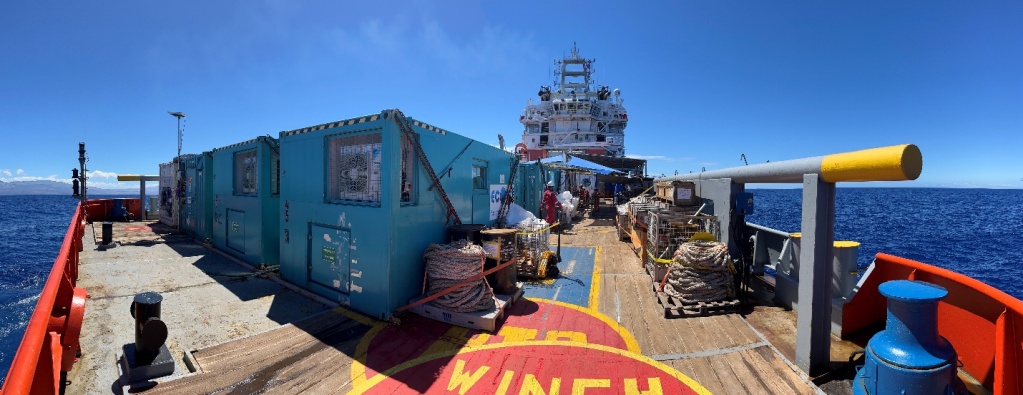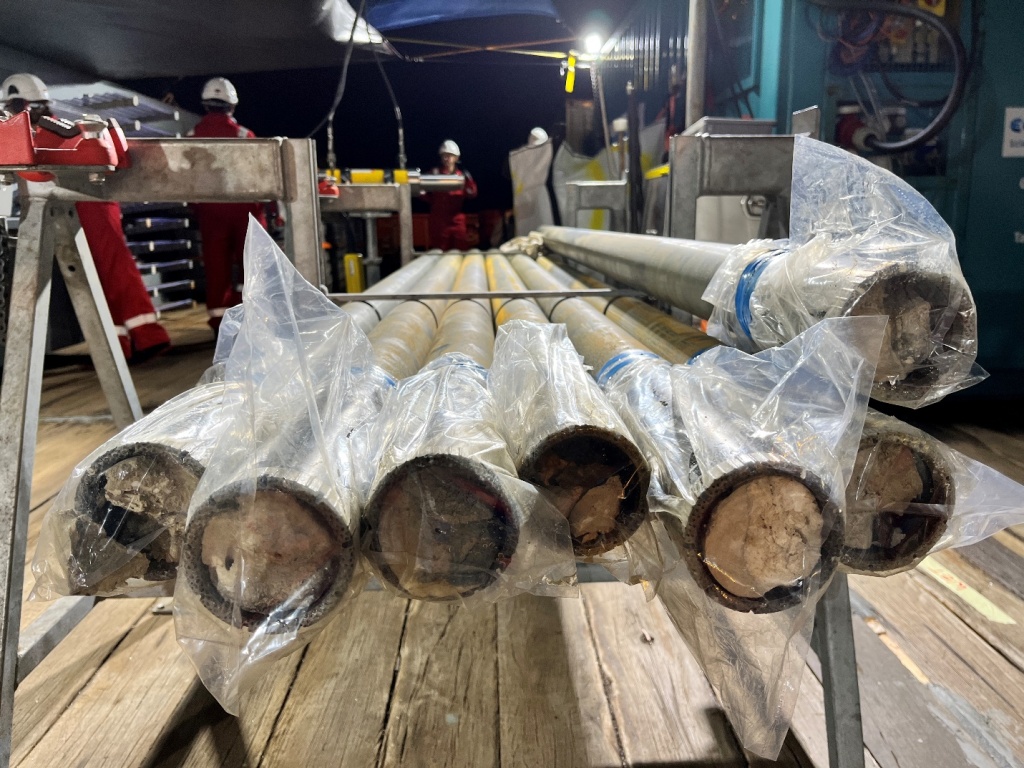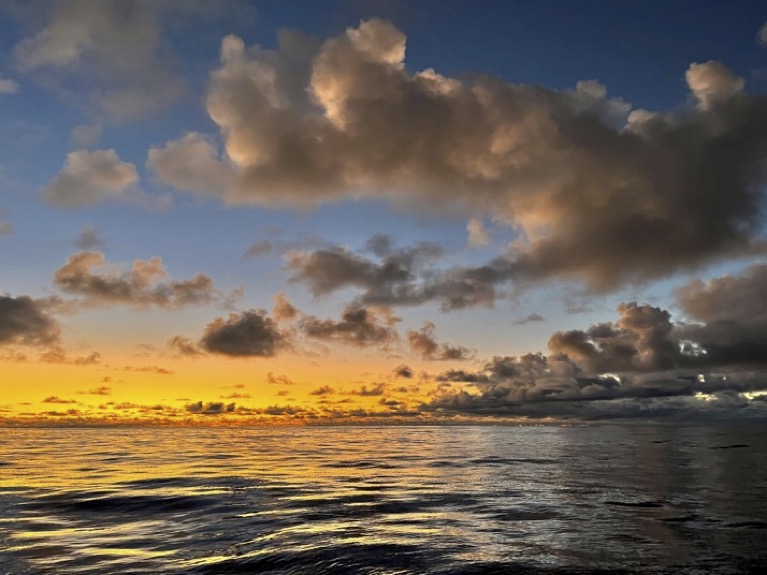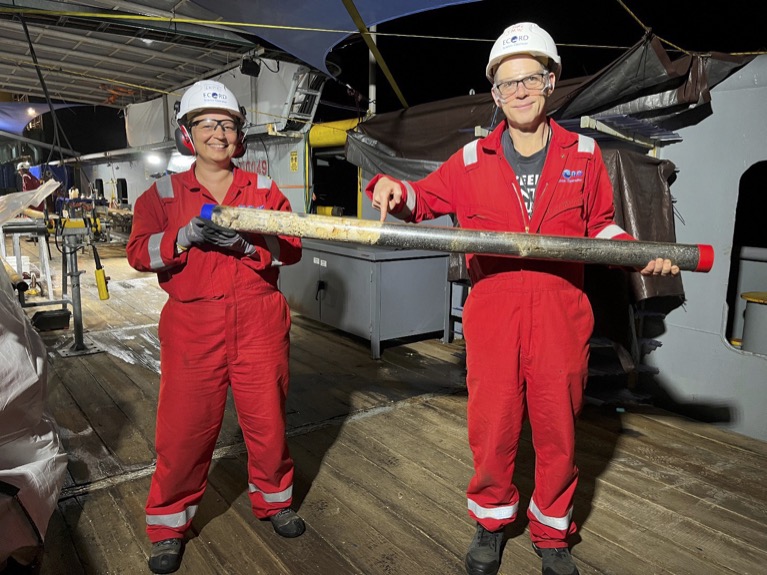航海概要
| 航海名 | Expedition 389: Hawaiian Drowned Reefs |
| プロポーザル/ Scientific Prospectus | ・プロポーザル #716 ・Scientific Prospectus |
| 共同首席研究者 | Jody Webster and Christina Ravelo |
| 掘削船 | MMA Valour, equipped with the Benthic Portable Remotely Operated Drill (PROD5)(Mission Specific Platform) |
| 航海予定期間 | Offshore (乗船): 2023年8月31日~10月31日 Onshore Science Party (航海後の陸上分析): 2024年2月6日~26日 |
| 乗船/下船地 | Barbers Point Harbor, Hawaii |
| ECORDのページ | https://www.ecord.org/expedition389/ |
| 掘削地点 |  ハワイ島近海 沈水サンゴ礁 |
| 科学目的 | 本航海では、ハワイ周辺の海底下134~1155mに存在する沈水サンゴ礁を掘削します。ハワイは過去に、1000年間で2.5~2.6cmという、急速な、しかしほぼ一定の速度で沈降しました。その結果、100~200mもの厚さにわたり浅部サンゴ礁の一連の層が、海底下に保存されています。これらのサンゴ礁は、地球の気候変動において重要な時期に生息していたと考えられます。掘削により、過去50万年間の古気候の解明、詳細な海水準曲線の復元、突然の気候変動に対するサンゴ礁の生態学的な応答、さらにはハワイの沈降と火山活動の歴史を解明することが目的です。 The overall goal of the drilling campaign is to sample a unique succession of drowned coral reefs around Hawaii now at -134 to -1155 m below sea level. As a direct result of Hawaii’s rapid (2.5-2.6/kyr) but nearly constant subsidence, a thick (100-200 m) expanded sequence of shallow coral reef dominated facies is preserved within the reefs. These reefs span important periods in Earth climate history, either not available or highly condensed on stable (Great Barrier Reef, Tahiti) and uplifted margins (Papua New Guinea, Barbados) due to a lack of accommodation space and/or unfavourable shelf morphology. Specifically, these data show that the reefs grew (for ~90-100 kyrs, albeit episodically) into, during and out of the majority of the last five to six glacial cycles. Therefore, scientific drilling through these reefs will generate a new record of sea-level and associated climate variability during several controversial and poorly understood periods over the last 500 kyr. The project has four major objectives: 1) To define the nature of sea level-change in the central Pacific over the last 500 kyr, we will construct a new, more complete sea level curve from the drowned Hawaiian reefs that will allow: a) more detailed testing of Milankovitch climate theory predictions and; b) improved constraints on millennial-scale sea-level changes over the last 500 kyr. 2) To identify critical processes that determine paleoclimate variability of the central Pacific over the last 500 kyr, we will: (a) reconstruct the mean and seasonal/interannual climate variability from massive coral samples; and (b) use these records to investigate how high latitude climate (e.g., ice sheet volume), pCO2, and seasonal solar radiation impact subtropical Pacific climate. This approach can be used to test theoretical predictions of climate response and sensitivity to changes in boundary conditions and climate forcing. 3) To establish the geologic and biologic response of coral reef systems to abrupt sea-level and climate changes, we will: (a) establish the detailed stratigraphic and geomorphic evolution of the reefs in response to these changes; (b) test ecologic theories about coral reef resilience and vulnerability to extreme, repeated environmental stress over interglacial/glacial to millennial time scales; and (c) establish the nature of living and ancient microbial communities in the reefs and their role in reef building. 4) To elucidate the subsidence and volcanic history of Hawaii, we will: (a) refine the variation through space and time of the subsidence of Hawaii, and; (b) improve the understanding of the volcanic evolution of the island. 詳細については、ECORDのページをご参照ください。 |
| プレスリリース | 航海開始のプレスリリースがECORDよりありました。(2023/08/30) https://www.ecord.org/iodp-expedition-389-press-release-2023/ |
J-DESCからの乗船研究者
| 氏名 | 所属 | 役職 | 乗船中の役割 |
|---|---|---|---|
| 浅海 竜司 | 東北大学 | 准教授 | Inorganic Geochemist |
| 横山 祐典 | 東京大学 | 教授 | Inorganic Geochemist |
| 福與 直人 | 産業技術総合研究所 | 学振特別研究員 | Paleomagnetist |
| HUMBLET Marc | 名古屋大学 | 准教授 | Coral specialist_Offshore |
- * ご所属は、乗船研究者選考時のものです。
船上レポート
-
船上レポート1
(2023年 9月21日受領)
-
Coral reefs, sunrises, and doughnuts – IODP Expedition 389 (Hawaiian Drowned Reefs)
-
船上レポート2
(2023年10月21日受領)
-
Milestone, close call, and lots of nice cores – IODP Expedition 389 (Hawaiian Drowned Reefs)
船上レポート1:Coral reefs, sunrises, and doughnuts – IODP Expedition 389 (Hawaiian Drowned Reefs)
Marc Humblet (Nagoya University)
I arrived in Honolulu a few days before boarding the ship that was to become my home for two months, just enough time to buy a few items that I had overlooked in my travel checklist, and more importantly, to meet other members of the science team, some who I already knew, some who I was meeting for the first time.
We boarded on the 31st of August. Our ship is the MMA Valour, an 84 m long multi-purpose platform supply vessel. IODP Expedition 389 is a mission specific platform expedition, which means that the ship had to be transformed to fulfil the requirements of the mission. For this expedition, a remotely operated seabed coring system was loaded on the ship, and containers were installed at the rear to accommodate lab facilities and the equipment needed for coring.
We departed from Honolulu in the evening of the 31st, and after some testing of the coring equipment offshore Oahu, we transited to our first coring site off the western coast of Hawaii (the Big Island). Since then, we have been staying in the same area and are now stationed about 10 km from the coast. From where we are, we have a stunning view of Mauna Kea, the tallest volcano in Hawaii.
Work on the ship is organized in shifts: a day shift and a night shift. I was assigned to the night shift, which means that I work from midnight to noon. I wake up every day at 11:00 pm, have my breakfast at 11:30 pm, my lunch at 6:00 am, and my dinner at 12:00 am. The first few days are tough, but you ultimately get used to it. There are advantages to the night shift. One is the quietness you experience during the night-time hours. You also get to see a beautiful sunrise every morning (daily contemplation time guaranteed!). You escape most of the afternoon heat, and – in my opinion, a crucial advantage – you get to enjoy the morning doughnuts, a perfect excuse to take a well-deserved pause during your shift!
Our expedition is collecting cores from submerged fossil coral reefs around the island of Hawaii to reconstruct the history of sea-level and climate changes over the past 500,000 years and understand how coral reefs and reef organisms have responded to environmental changes.
It has been extremely rewarding to see the cores that were brought on deck and discover for the first time these amazing sequences of fossil reef framework, preserved for tens or hundreds of thousands of years under the seafloor, and now revealing the beauty of an ecosystem teaming with life in the distant past. I cannot wait to see more of them!



船上レポート2:Milestone, close call, and lots of nice cores – IODP Expedition 389 (Hawaiian Drowned Reefs)
Marc Humblet (Nagoya University)
A port call in Honolulu at mid-expedition (after four weeks at sea) gave us the opportunity to stretch our legs and finally (finally!) enjoy a short dip in the ocean (the sensation of delight cannot be described with words). Our outing on land lasted just a few hours but was enough to start the second leg full of renewed anticipation and energy.
We are now entering the third week of the second leg. Only a little over two weeks has passed since the port call, and yet so much has happened that I feel it must be longer.
The second leg started with a milestone: the 100th mission specific platform (MSP) site cored since the start of MSP expeditions in 2004. From the Arctic to the tropics, 100 sites, 10 expeditions, nearly 20 years of discovery. IODP Expedition 389 is the third MSP expedition targeting submerged fossil reefs after IODP Expedition 310 (Tahiti) and 325 (Australia’s Great Barrier Reef).
Then, as coring was under way, and we were easing into what should have been a quiet night shift… our ship suddenly started to drift away. This was not good news. Since the remotely operated seafloor corer is connected to the ship by a cable, the ship must always remain close to the coring site at a specific location. To do so it is equipped with a dynamic positioning (DP) system. The DP system knows the position of the ship thanks to GPS signals received from satellites and always maintains the desired position by activating thrusters at the bow and stern. The loss of GPS signals caused emergency recovery to be activated, and the corer was quickly lifted from the seabed and brought back onboard … intact. A relief!
Soon after this unfortunate event, we transited to the windward side of Hawaii and resumed coring operations. All pessimism that we may have felt at that point vanished during the few days that we have now spent on this side of the island. We have seen some of the most impressive core sections collected since the start of the expedition.
One borehole penetrated a 30 m thick section of fossil coral reef and reached a basaltic lava flow buried underneath – a unique sequence of strata, frozen in time for hundreds of thousands of years, telling a vivid story of volcanic eruptions followed by the birth and demise of a rich ecosystem. The contact between the basalt and the first corals above shows the very moment when reef growth initiated as sea level rose and the newly available substrate was colonized by corals and other reef organisms.
Another section of fossil coral reef, this time 46 m thick, was cored at a shallower site, exposing the interior of a fossil reef formed tens of thousands of years ago. After bringing back the seafloor corer and its precious cargo onboard, the core liners were pulled out from their barrels and their content unveiled, revealing striking patterns of pale yellow, white, and grey colors. This seemingly abstract design is produced by the three main components of the coral reef framework: corals, algal crusts, and microbialite, a sediment whose formation is mediated by microbial activity.
As we are nearing the end of the coring operations, we are already planning for the next phase of the expedition, when the cores will be split lengthwise, and the clear-cut sections will reveal their content with much more details. The onshore science party will take place at the IODP Bremen Core Repository (BCR) at the MARUM – Center for Marine Environmental Sciences, University of Bremen, Germany, and will mark the beginning of an in-depth analysis of all the cores that we have collected to extract as much information as we can about climate and sea-level changes and their impacts on coral reef ecosystems. Another exciting journey will then begin!

Sunrise over a calm sea. Credits: ECORD/IODP.

The contact between the basalt (black) and the reef section (white) representing the initiation of reef growth. From left to right: Luzie Schnieders and Jody Webster. Credits: ECORD/IODP.

Fossil coral reef framework composed of corals (pale yellow), algal crusts (white), and microbialite (grey). The length of the section is 145 cm. Credits: ECORD/IODP.
